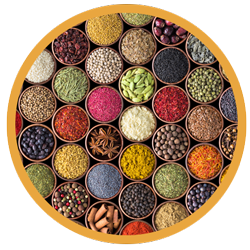All About Spices- The Indian Secret to Health and Taste
India, being the largest exporter of spices, is home to over 50 varieties of spices that it cultivates in various parts of the country. Depending on the terrain and climatic conditions, different types and species of spices are grown nationally.
List of spices:
- Basil
- Bay Leaf
- Black Pepper
- Asafoetida
- Black Salt
- Cardamom
- Caram seeds or Celery seeds
- Cinnamon
- Cloves
- Coriander
- Curry Leaves
- Caraway seeds
- Dry mango powder
- Fennel
- Ginger powder
- Gooseberry Grass
- Garlic Powder
- Mace
- Mustard seeds
- Mint
- Turmeric
- Tamarind
- Star Anise
- Sesame seeds
- Rose Petal conserve
- Rock Salt
- Pomegranate seeds
- Saffron
- Dried red chili
- Sugar

How to store spices:
Storage of spices is a vital part of using the best out of them. Spices tend to lose their flavor and deteriorate when exposed to air or stored in the open, bright areas. Therefore, they have to be stored in a dry, cool area(preferably an airtight container) where they are isolated from moisture and other absorbents.
Shelflife of spices:
Spices, if stored properly, can be fresh and ready to use for more than a year. Depending on the type of spices, the period can vary from 1-3 years until they lose their freshness.
Where to buy them:
One-stop location for anything Indian is MyHomeGrocers(MHG). MHG has been importing various spices exclusively from India to seamlessly deliver the big Indian community in Dallas, TX, for the past three years.
Health benefits of spices:
Spices are not just ingredients of recipes but have been traditionally used to treat ailments and chronic diseases through Ayurveda. Here are some spices that are used for specific purposes.
Digestion:Cumin, fennel, and coriander seeds.
Vit C:Anice, Chili pepper, Cardamom, tabasco, jalapeno
Antioxidants:Clove, cinnamon, oregano, pepper, sage, rosemary
Antibacterial and anticarcinogenic: Turmeric
How to add them to your food:
Spices are added to the food while cooking either at the start or the end of the process depending upon their strength and intensity. Some spices are added to precooked food as well. A perfect blend of different spices would be a good fit for wholesome curries or dal, while a few added to the tempering or seasoning would give it a remarkable tinge to the recipe.
One can add spices to hot soul-warming soups, cold refreshing drinks, delicious lunch bowls, tasty creamy desserts, or just a glass of water for additional taste and goodness!
How to add them to your beauty routine:
Turmeric: Turmeric is antiinflammatory and makes the skin look bright. Mix turmeric, gram flour, and milk to make a paste. Apply it on the skin and wash after 10 min.
Saffron: Reduces acne and helps the skin to glow. Add a few strands of saffron to water or milk and apply it to the surface and wash after two minutes.
Cinnamon: Increases blood circulation. Grind cinnamon into a paste and use it as a scrub.
Basil: Antibacterial and anti-aging. Crush two to three leaves in double parts of water and apply it to the face.
Similarly, most of the other spices can be used with care to treat many modern skin problems.
Therefore, with loads of benefits, spices should be made a necessary kitchen ingredient in every household.



Leave your comment
Note: HTML is not translated!